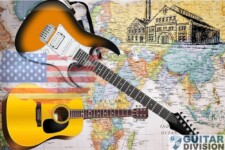What Size Guitar is Best for Beginners? Find Your Match
For beginning guitarists, trying to figure out the best guitar size can be overwhelming and frustrating. Understanding guitar sizes and bodies involves lots of technical jargon that can be confusing.
Besides considering your preferred music style, the easiest way to determine the best guitar size is to match the guitar size to the player’s size.
Beginners often like smaller guitars such as parlor guitars because they are easier to get your strumming arm around. When it comes to electric guitars, many beginners choose a Stratocaster for their easy to hold shape.
It can be more complicated though, as not every guitar type is suited to every player, so let’s find out what will suit you best.
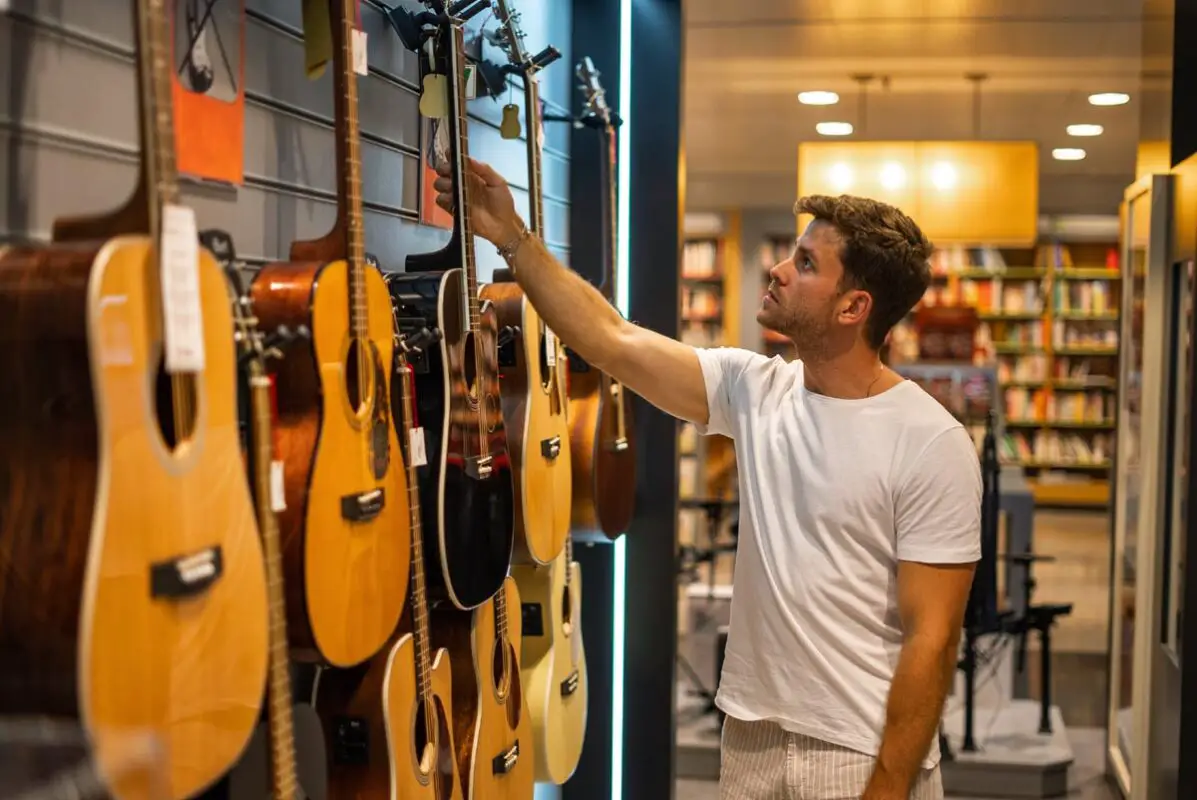
Technical Guitar Stuff
Guitar sizes are confusing because they cover a vast array of specifications. From guitar bodies, scale sizes, and nut widths, to the differences between electric and acoustic guitars – there’s a lot of information involved!
So let’s not over-complicate things, but rather look at the different sizes in an easy to understand way.
Understanding these basics will help you find the best guitar size for YOU.
Finally I’ll help you match body sizes for adults, teens, and kids to appropriate guitar sizes.
Hand And Body Size
Arguably the most important factor is guitar body size, because your hands only stretch so far. Smaller hands will require smaller guitar bodies and necks, making it easier to reach the fretboard.
A good rule is to measure the distance between the thumb and pinky while your hand is spread out. If the span is over 6.7 Inches (170mm), then you should be able to play a full-sized guitar without any problems.
If it’s less, then consider a scaled-down ½- or ¾-sized guitar for best comfort.
Your body size also plays a crucial role and should be related to the guitar size. Generally, small hands and short arms struggle to learn on larger guitars.
Acoustic Guitar Bodies
Acoustic guitars basically have two large rounded sections, with a narrower waist in between. The largest round section is called the ‘lower bout’, and yes you guessed it …the smaller round section is the ‘upper bout’.
Larger body guitars have a larger lower bout, and are also deeper from the front of the guitar to the back, and this can be harder to handle for smaller players, particularly beginners.
Acoustic guitars come in a variety of sizes from Parlor to Jumbo with bout sizes ranging from twelve inches to almost seventeen inches, yet all of them are considered full-sized. Simply realize that you have small, medium, and large guitars that are all considered “full-sized.”
Some guitar makers have different names for shape or size of their guitars, but basically they will fit into one of the following categories.
Here’s a quick rundown on the various guitar body sizes from small to large:
1. Travel or Mini Guitars
While not considered full-sized guitars, mini-guitars are especially crafted for portability and have become quite popular. They have smaller bodies, and therefore aren’t very loud, but offer great mids and highs with very controlled bass.
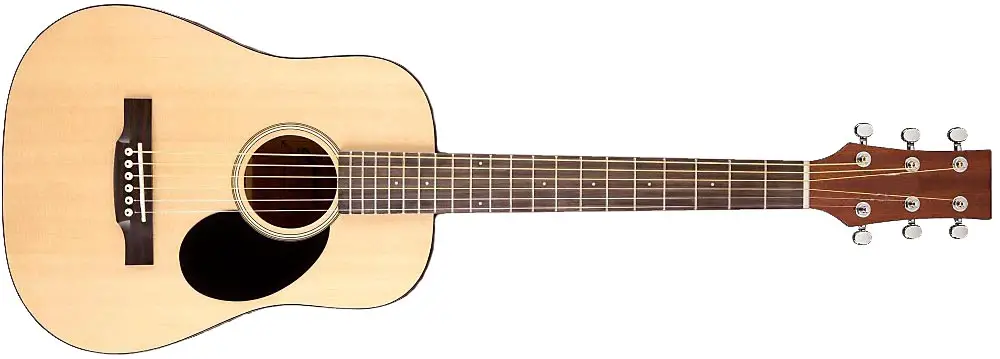
Mini guitars are a great option for young kids to get started on, and can still be fun for adults. You won’t get the same deep bass sounds out of these small guitars as a larger model, but can still have a good sound quality.
Many new travel guitar designs have appeared in the last few years, so there are tons of interesting choices. If you’re after a guitar to travel on flights with, or just a small guitar to keep near the lounge, they can be a great option.

2. Parlor Guitars
Parlors are the smallest full-sized guitars, and as such, they’re not very loud and don’t have an abundance of bass. However, they can be a good choice for people with small hands.
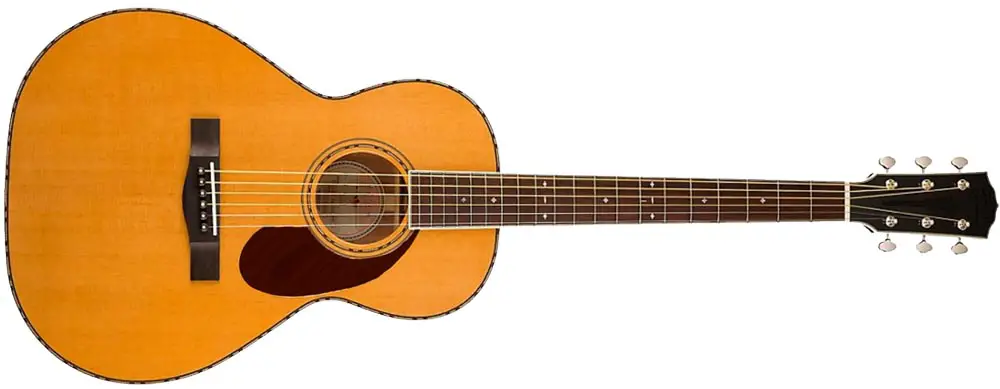
These guitars can sound a bit boxy and tinny in the cheaper versions, and you would likely outgrow one musically within a year if you play regularly. There are more expensive models that have a fuller sound, but most beginners won’t want to spend so much on their first instrument.
3. Concert & Grand Concert Guitars
These full-sized versions are slightly bigger than the Parlor, but smaller than the Auditorium. They’re good for both big and small players because they’re lightweight and easy on the hands. They have diminished bass, but pronounced mid and high tones.
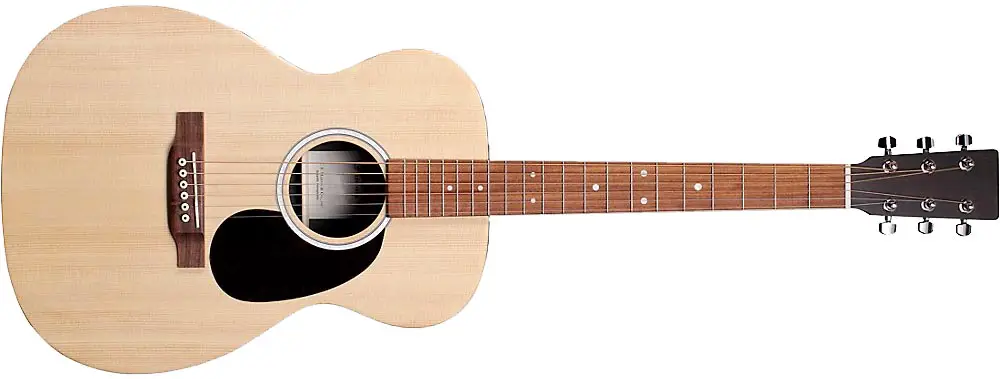
Concert guitars will produce a slightly deeper tone than a parlor guitar, and if you’re after a mid-sized comfortable guitar to get started on, these could be a good choice.
4. Auditorium & Grand Auditorium Guitars
The full-sized Auditorium has a skinnier waist than the Dreadnought making it ideal for beginners who struggle with larger guitar bodies. They do well at balancing across all six strings with good mids and highs, but don’t have a big, boomy bass.
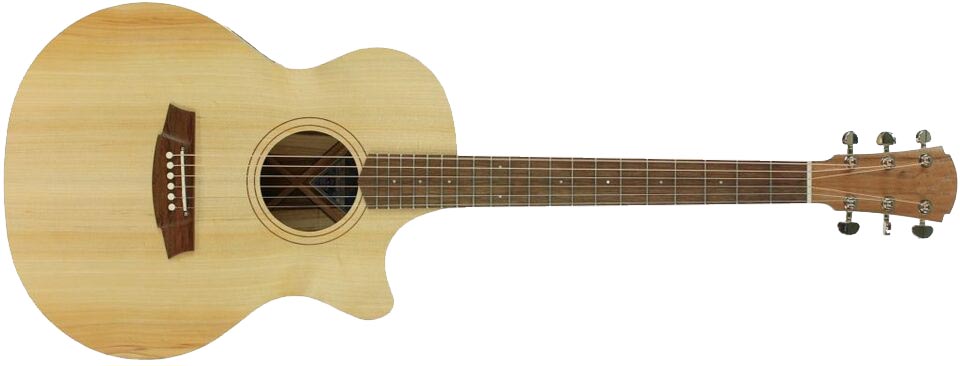
These guitars are great for learners who like the idea of learning fingerpicking and flatpicking, and lend themselves well to this style of playing.
5. Dreadnought Guitars
The most common of the full-sized acoustics, their bodies are quite large, but not as large as the Jumbo. The body of these guitars is deeper than Concert guitar, meaning your strumming arm has to reach further to the strings.
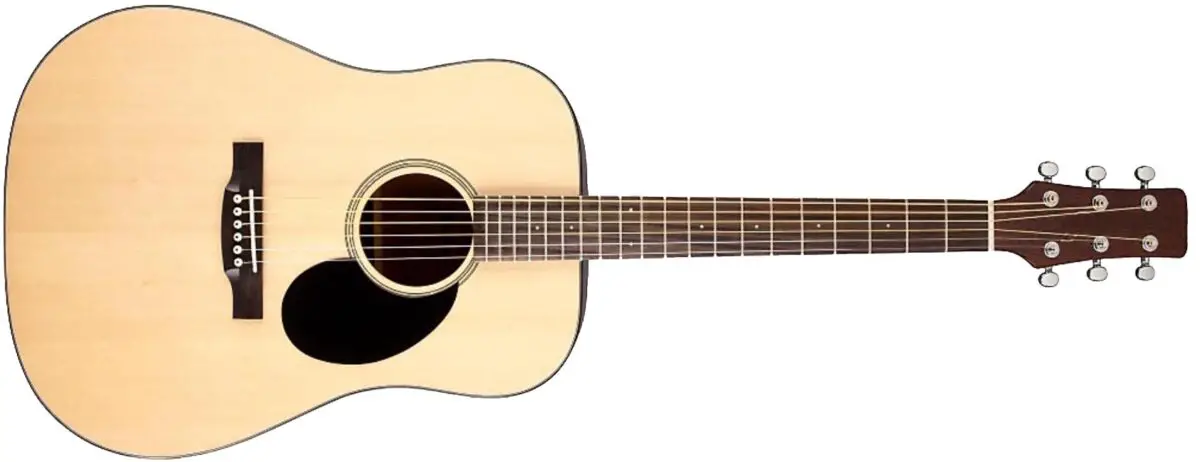
Dreadnoughts are good for almost any adult, but younger kids may find them difficult to play.
If you like the idea of strumming strong rhythms with a good punchy rich tone, then you will love Dreadnoughts. These are the most popular style of acoustic guitar, and you will see them played regularly on stage.
For many older teens and mid-sized adults upward, dreadnoughts are likely the best choice for a guitar that allows you to play many styles, and are plenty loud enough to play with other musicians.
6. Jumbo Guitars
Jumbo guitars are the largest and are great for big power chord and open chord playing. They have a projective rich sound with distinctive treble and bass. They have big, wide bodies that are likely unsuitable for children or small-framed adults.
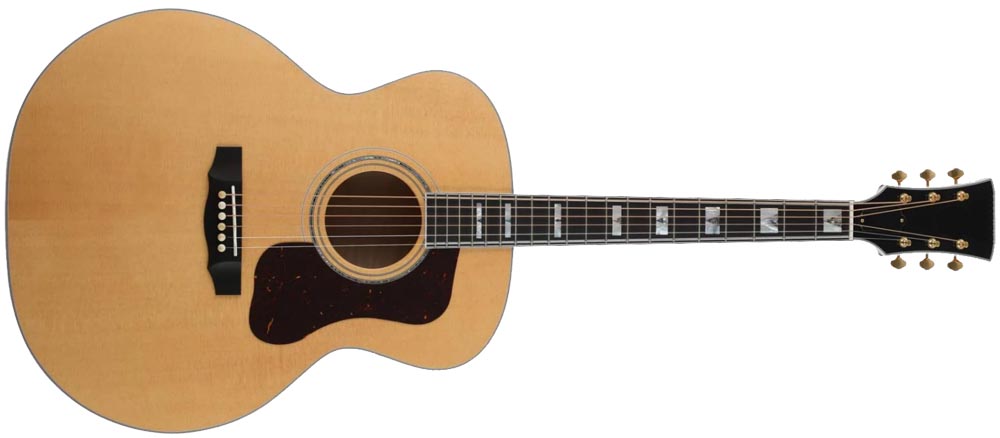
Many learners will find a Jumbo too big to handle until they gain some more playing experience.
Scale Sizes
Besides body sizes, there are also a variety of scale sizes, which are smaller versions of full-sized models. The key to finding the right guitar size is matching your body size to the correct scale size.
Scaled guitars come in both electric and acoustic and include ¼-, ½-, ⅞-, and ¾-sizes. Scaled versions offer the same spectrum of full-sized guitars, just in smaller form. You could have a ¼-sized Dreadnought, or a ¼-sized Auditorium.
Body Lengths
The overall guitar length is different from the scale length. While scale length measures from nut to bridge, overall length is measured from neck to bout. So not only do full-sized guitars come in various body styles, but they also come in various lengths.
Proportional to their body sizes, Parlors are the shortest full-sized guitar with overall lengths around 38”. Whereas, the full-sized dreadnought usually has an overall length of 41”.
The ¼-, ½-, and ¾-sizes also scale down body lengths providing many options to choose from. The more scaled the guitar the easier it is to hold for smaller hands.
Nut Widths
Nut widths are equivalent to neck widths down near the tuning pegs, which is key in determining the right size for your hand. Smaller nut widths work better for smaller hands; likewise larger nut widths for larger hands.
Some guitars are made with quite narrow neck width at the nut (mainly some electric guitars), and if you are just learning this can make it harder to cleanly press a string without touching others – since the strings can be closer together.
Electric vs Acoustic Guitar Size
Electric guitar sizes don’t vary as much as acoustics do because they get their sound in a completely different manner. There are no electric equivalents of Parlor, Dreadnought, Auditorium, etc. Electric guitars simply come in ¼, ½, ¾, or full.
Electric guitars have some variety in their frets with 21, 22, or 24 frets, but guitar bodies and necks don’t change in size that much. Instead, they offer variety in their cutaways and neck profiles (the shape of the rounded part of the neck).
When comparing full-sized electrics with acoustics, electrics always have smaller bodies. They’re also much thinner and more contoured to fit naturally against your body, often making them more comfortable for smaller individuals.
Keep in mind though that electric guitars weigh more than acoustic guitars, and some designs like the Les Paul are heavier than other electric guitar bodies like the Stratocaster. The best way to know how heavy they are is pick a few up in a guitar shop (or a friend’s house), and see if the weight is ok for you.
Best Size Guitars for Adult Beginners
The best-sized guitars for adults will depend on the size of the individual, but ½, ¾, or full-sized are all viable options. Smaller players should probably avoid Dreadnought and Jumbo bodies.
For an average or large-sized adult there really aren’t any restrictions, but many beginners feel most comfortable with ¾ sizes; however, small people with a shorter arm-span generally prefer ½-size options. Smaller individuals might also choose electric over acoustic for an even better fit.
Generally with adults, most people will choose Dreadnought, Auditorium, or concert sized guitars to get started on (from largest to smallest).
Should You Choose a 38” or 41” Acoustic Guitar?
38 Inch and 41 Inch refers to the overall length of a guitar from the end of the body to the end of the neck. A 38 Inch guitar is still considered full size, and taller players still love playing guitars this size.
Choosing one size over another often comes down to your height, as people with shorter arms will find a smaller guitar easier and more comfortable to play. Here’s a rough guide:
- Shorter people, 5’2” or less, prefer 38” guitars because they’re more comfortable to play.
- Medium to tall people usually prefer 41-inch guitars, which also provide a fuller, louder sound with more bass.
What Type of Electric Guitar Is Best for Adult Beginners?
Choosing the right electric guitar depends on the type of music that you want to play. Some are designed for rock, some for blues and jazz, others for shredding. The Stratocaster and Les Paul bodies are two of the most popular bodies within the guitarist community, and it really comes down to preference.
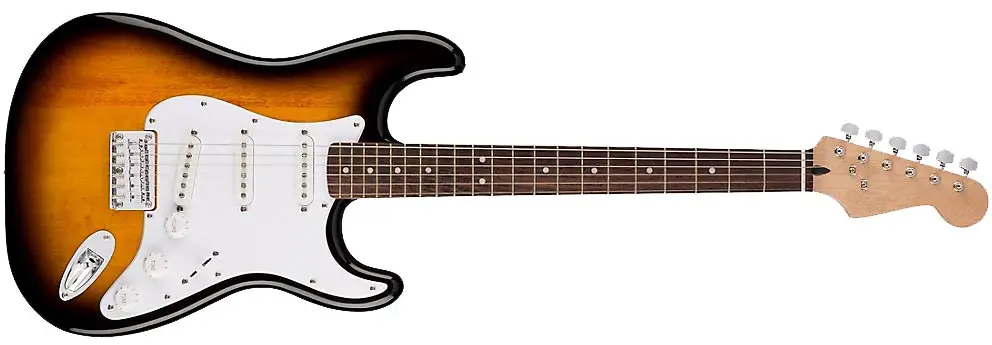
Stratocaster Electric Guitar
Other things to consider include the type of wood used. Not only does wood affect the overall sound, but some woods, such as Mahogany, are much heavier than others. Beginners often prefer thinner necks because they allow for easier chord transitions.
If you’re looking for a good, can’t-go-wrong, entry-level guitar, then Squier would be a good option. Whether it’s the Stratocaster, Bullet, or Affinity, all cater to entry-level, budget-conscious players; and they’re reputable enough that you know you’re getting good quality.
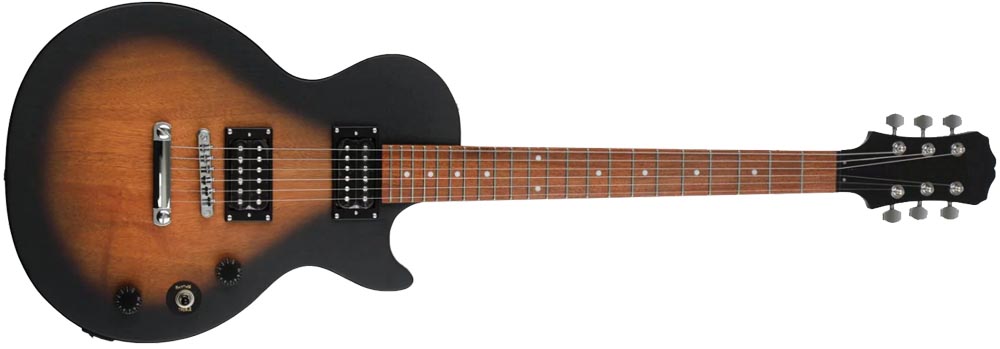
Les Paul Electric Guitar
If you prefer the Les Paul body style, then Epiphone makes a good beginner line that includes the Epiphone LP, or the Les Paul SL.
Best Size Guitars for Teenager Beginners
For younger teens with smaller bodies try Parlors, Concerts, or Auditoriums in ½- to ¾-size. These guitars are ideal for anyone 4 ½ to 5 feet tall.
The ½-sizes generally fluctuate between a scale length of 20 ½ to 23 ¾ inches and an overall length of 33 to 34 inches.
While the ¾-sizes usually have the same scale length, their overall length is usually longer, around 36 inches.
Younger teens on the small side could also consider mini guitars as an option, as well as ½- to ¾ electrics guitars.
For older teens that are 5’ or taller, ¾ to full-size in any body style suffices just fine. Full-size guitars generally come with a scale length of 25 ½ inches and an overall length of 38 to 41”. The same perimeters for beginning adults would also be suitable for older teens.
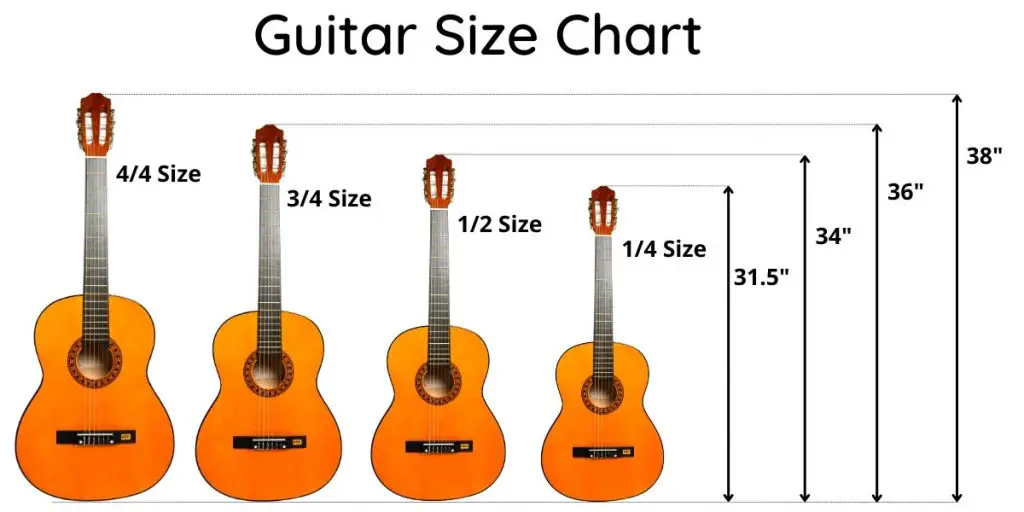
Best Size Guitars for Young Children
When buying for young children, the right size depends a lot on age and weight, but Parlors, Concert Grands, and Travel guitars are good options because of their smaller bout sizes.
For kids younger than 5, a ¼-sized guitar will be your best bet. It allows the best access to the neck and has a shorter scale length under 20” with an overall length around 30”. A Parlor body or electric Stratocaster would be the best body type for this age group.
Children between 6 and 8 will find ½-sized guitars more suitable. They’re ideal for children between 3 ½ to 4 ½ feet tall. They usually have scale lengths in the low twenties and overall lengths around 33 to 34 inches.
For older children between 8 and 10, ¾-sizes work best. They’re designed for those in the 4- to 5-foot range and have scale lengths around 23 to 24 inches with overall lengths around 36 inches.
Anyone over 5’ tall should be able to play full-sized guitars without any problems. Simply choose your preferred body style.
Found Your Guitar Size?
Guitar specifications can be quite a headache and require a great deal of study to fully make sense of it all.
The simplest way to determine the best guitar size is to keep it proportional to your body. Find one that’s comfortable, that provides easy access to the neck in order to transition from one chord to the next, and avoid uncomfortable stretching or wrist strain.
Finally, think about what style of playing you want to learn, as some guitar types are better suited to certain musical styles.

